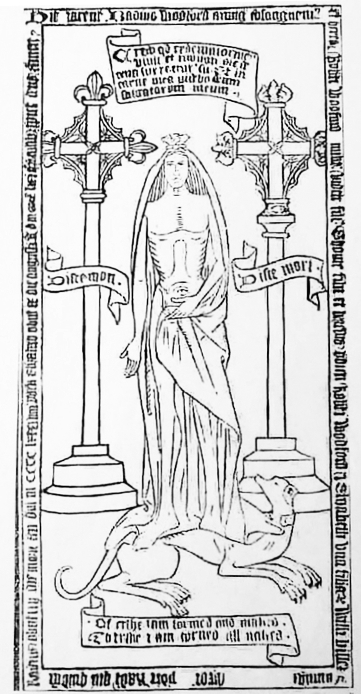Ralph Woodford of Ashby Folville
There is little firm
evidence of his personality and beliefs with the exception of his
will, but Ralph Woodford (1430-1498) appears as an enigmatic figure in the
Woodford story.
Having experienced the death of his father at an early age followed by the antagonism of his grandfather, Ralph represented the sixth and last generation of the family to hold significant property and influence in Leicestershire. After his death, the family in Leicestershire dispersed.

The
dispute over Ralph's inheritance lasted long after the death of
his grandfather. The breach between Ralph and his uncle Walter, for instance, was
so complete that Walter apparently feared for his life at his nephew's
hands.
The records indicate that Ralph was determined to seize Walter's portion of the family's lands, and if necessary to hold it by force. Walter was unable to defend his rights as he lived `far out' of Leicestershire, so Ralph's illegal entry onto the property endured for over ten years.
Ralph's somewhat violent attitude to his uncles may be understood in the context of the family's social standing in Leicestershire. Sir Robert's attempts to disinherit his grandson threatened Ralph's wealth and consequently the entire family's status within county society. Despite his grandfather's protestations, Ralph remained married to Elizabeth Villiers until her death on 9 August 1469, twenty-two years after their marriage. Elizabeth was buried in Ralph's vault in the church at Ashby Folville.

However, Ralph's will, written in English and made on 15 April 1495, mentions two wives, Elizabeth and Margaret. William Villiers had four children from his first marriage (to Agnes Beler). Elizabeth was the eldest of these children. Harl.MS 7178 Fo 15 states that Elizabeth married Ralph Woodford in 1495, but this is the date of Ralph's will. No document has been found to identify Ralph's other wife except his will, proved on 29 May 1498.
Most pedigrees indicate that Ralph had four sons, the eldest being William who died before his father. This William married Anne Norwich of Brampton, Co. Northants. Their only child, Margaret (born 1479/80), inherited much of Ralph's lands and property.
Ralph's sons appear to be much younger than William and may therefore be the sons of Ralph's second marriage. Almost ten years before writing his will, Ralph conveyed to the Augustinian Priory at Owston for eighty years, 2s in annual rent for a messuage and croft in Twyford in return for an annual requiem mass with placebo and dirige for the souls of Ralph and his wife Elizabeth.
Ralph's will states that he desires to be buried in the chancel of the parish church of Ashby Folville before the image of Our Lady where his wife lies. To the making of which chancel he paid five marks and more. He left 4d to be paid to every priest who attended his funeral, 2d to every surpliced clerk and 1d to all clerks `without surplice'. To Ashby Folville church he left his mess booke, his portewes (portable breviary) with a new coupe, and two pounds to the `making of the stepill'.
There are many benefactions to other churches including his private chapel in the parish church at Sproxton. Ralph also gave (a modest) 13s 4d to the poor, but forgave his poorest tenants a quarter year's rent. He ordered prayers for his cousin John Bellers, for all his ancestors in general and for his great-grandparents in particular. He died on 4 March 1498.
Nichols notes that the East window in the south aisle bore a portrait of Ralph, his wife and all his children. This is no longer in place. A modern window on the North side of the nave is in memory of Neville Woodford Smith Carington, 1878-1933.
A two-light window with an elongated quatrefoil was moved from the church to the chapel of Trinity Hospital in the Newarke in Leicester by the architect Thomas Nevinson The window is located in the vestry on the north side of the chancel. The building is now owned by De Montfort University and is known as Trinity House.
Ashby Folville manor was rebuilt following a serious fire. Only the North wing is old, dating from 1516. The contents of the building were auctioned, and the house sold, by Wing Commander John Smith-Carington in 1984. The house was sold again 1992.
